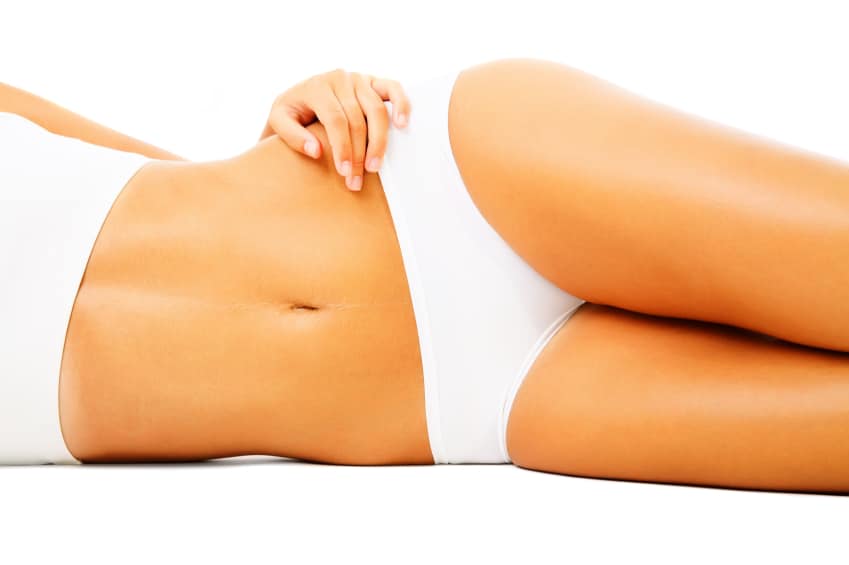Have you noticed what appears to be tiny scars on various parts of your body and wondered how they got there? These small, off-color scars might be stretch marks.
Stretch marks, while not painful or problematic, can be embarrassing, especially if they are located on a part of the body that is highly visible. Our Licensed Medical Aestheticians Melissa Valdez and Susan Lujan can help you find a treatment option that will dramatically reduce stretch marks.

What are stretch marks?
Stretch marks are long, narrow streaks or lines that show themselves on the skin and are a different hue than the surrounding skin. As their name implies, stretch marks are caused by sudden stretching of the skin. Stretch marks form in the dermis, the middle layer of the skin. They can form in most areas of the body but are most common in the stomach area, thighs, hips, breasts, upper arms, and lower back. Men and women can both develop stretch marks, but they are most common after pregnancy. Hardly anyone is immune — around 90 percent of women develop stretch marks after their sixth or seventh month of pregnancy.
What are the first signs of stretch marks?
Before stretch marks begin to emerge, the skin can appear thin and pink. It may feel irritated or itchy in that area. The first show themselves as wrinkly, raised streaks that can be red, purple, pink, reddish-brown, or dark brown, depending on your skin color.
What Causes Stretch Marks?
Stretch marks are simply the result of extreme skin growth or shrinkage. They form in the dermis when the connective tissue is stretched beyond the limits of its elasticity. This happens with rapid expansion or contraction of the skin. As the body grows with the weight gain, the connecting fibers in the skin’s dermis layer (under the outer epidermis) slowly stretch to accommodate slow growth. But when the growth occurs quickly, this leads to sudden stretching. This causes the dermis to tear, allowing deeper layers of skin to show through. This can then form stretch marks.
Are there different types of stretch marks?
There are two basic types of stretch marks, along with those during pregnancy. These are based on their formation and appearance. Most stretch marks will progress from the rubrae phase to the albae phase.
- Striae rubrae: Pink/red stretch marks
- Striae albae: White stretch marks
- Striae gravidarum: Pregnancy stretch marks
What Parts of the Body Experience Stretch Marks?
Almost any part of the body that is covered in the skin can experience stretch marks. However, there are certain areas that are more susceptible to stretch marks than others. Stretch marks commonly occur on the belly or waist, buttocks, lower back and sides, hips, thighs, and breasts.
Will Stretch Marks Disappear Over Time?
Over time, some stretch marks may fade so much that they are almost invisible to the naked eye. Unfortunately, this can take anywhere from six months to a year to occur. In that time, you are left with the very visible scars left behind by stretch marks.
Do stretch marks go away if you lose weight?
Unfortunately, no. Once the skin has been stretched and tears in the dermis layer have occurred, they will not heal. You can mask them with the collagen increase created with our laser treatments, but they never go away in a physical sense.
Treatment Options for Stretch Marks
If you are looking to reduce the appearance of stretch marks, you will have several options for treatment. Treatment options for stretch marks include topical creams and laser therapy.
Topical creams that contain vitamin E or hydroeprolisilane-C have may reduce the appearance of stretch marks. These topical creams must be used on a daily basis and it may be several months before the stretch marks start to fade.
Patients that wish to see quicker results may benefit from laser therapy. Laser treatment is relatively pain-free and can reduce the appearance of stretch marks in two to three office visits. ResurFX laser resurfacing can be used to reduce the appearance of stretch marks, along with a number of other skin imperfections.
How many treatments will it take?
It takes multiple laser treatments to actively improve collagen remodeling. We’ve found that from three to five treatments usually achieve the best results. Treatments are spaced from 6-8 weeks apart.
Are laser stretch mark treatments painful?
Treatment is quick, usually taking around 30 minutes. There is no need for local anesthesia, as the procedure is basically pain-free. Patients equate the feeling of the laser pulses to a rubber band lightly snapping on their skin.
How long do you continue to apply creams to reduce the appearance of stretch marks?
First off, know that no cream or topical salve has proven scientifically to absolutely reduce the appearance of stretch marks. Many products claim to be magically solutions but there is no such thing. They can reduce the appearance of stretch marks, but they need to be applied for several months and your results could be mixed at best.
Can stretch marks come back?
They won’t go away and come back; that’s because they never truly go away — the tears in the dermis layer are permanent. If you come in and have a ResurFX laser treatment your stretch marks will diminish in appearance, but they probably won’t fully vanish. They will be much less visible, however. After you do this, these stretch marks won’t change. But if you gain a bunch of weight, there’s nothing stopping your skin from forming new stretch marks.

Can I prevent stretch marks from developing?
The only sure-fire way to prevent stretch marks would be to not get pregnant and never gain a large amount of weight. Both of those situations cause the rapid stretching of the skin that causes the marks.
If you plan on having children, there are some things you can try to prevent stretch marks, but it’s almost impossible to not develop any. During your first trimester start moisturizing the areas where stretch marks are most likely to develop — your belly, lower back, breasts, and hips. As for weight, keep your increase to 25 to 35 pounds to not overstretch your skin.
In your second trimester, if you still start seeing red lines, you can reduce their future appearance by acting now. Mederma Stretch Marks Therapy is safe to use in the second trimester, and it has been clinically shown to significantly minimize scarring. You have to apply it daily, though, and it will take a couple of weeks to show improvement.
After the baby is delivered, you want to firm your skin. There are products like Mustela Maternity Body Firming Gel that can do so.
Once you start to see stretch marks, that’s time to see our aestheticians if you really want to decrease their appearance.
See What Our Patients Are Saying!
"Dr. Bucay is wonderful as is her entire practice! I love going to have treatments done at the office she always has the latest and greatest in anti aging solutions. I am honestly so grateful for her!!"
Schedule a Consultation
Our Licensed Medical Aestheticians Melissa Valdez and Susan Lujan can sit down with you and discuss treatment options that may help you reduce the appearance of stretch marks. Contact our La Casita location at 210.692.3000 or our Sonterra location at 210.370.9995.
